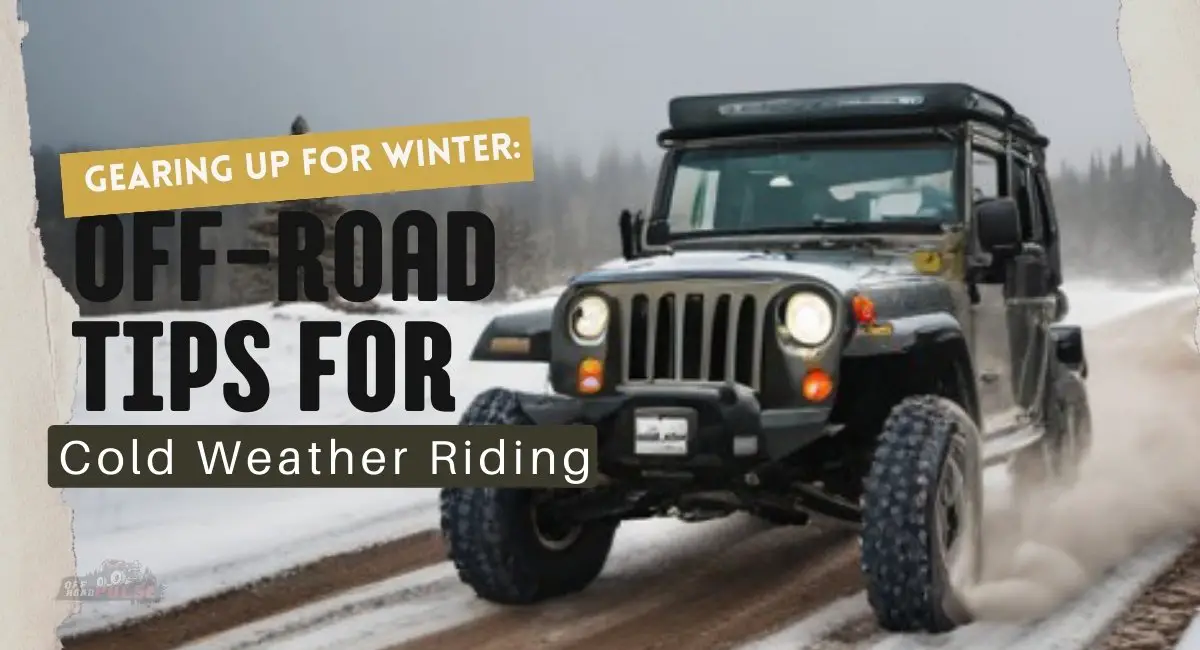Winter brings a special kind of magic to the world of off-road enthusiasts. Venturing into the wilderness at any time of year is an irresistible experience, but there’s something truly magical about hitting the trails during the winter months.
However, as exhilarating as winter off-roading can be, it also comes with its own set of challenges. Ideally, the cold weather poses unique obstacles that demand careful attention and preparation to ensure both safety and enjoyment on the trails.
Challenges of Off-Roading in Winter
Slippery Surfaces
Perhaps the most obvious challenge of winter off-roading is navigating slippery surfaces. Ideally, snow and ice are bound to reduce traction drastically, making it difficult to maintain control of your vehicle, especially when climbing steep inclines or traversing uneven terrain. As such, riders may want to be cautious and be prepared to adapt to changing road conditions.
Limited Visibility
Winter weather often brings reduced visibility due to snowfall, fog, and low-light conditions. Poor visibility makes it challenging to spot obstacles on the trail, including fallen trees, rocks, or deep ruts. This, in turn, increases the risk of accidents and getting stuck.
Cold Weather Hazards
Extreme cold temperatures pose safety hazards to riders and vehicles alike. For instance, extreme cold causes vehicle fluids to freeze, leading to engine damage or failure. Additionally, exposure to cold temperatures can pose health risks to riders and passengers, including hypothermia and frostbite.
Remote Locations
Many off-road trails are located in remote and isolated areas, which can pose additional challenges during winter months. Now, in the event of an emergency or mechanical breakdown, assistance may be difficult to access. Snow-covered trails can further hinder access, leaving travelers stranded or isolated during an emergency.

Preparations for Winter Off-Roading
Winter off-roading often means tackling challenging terrain, such as deep snowdrifts, frozen mud, or icy river crossings. As such, you may want to ensure that your vehicle is winterized properly for a safe and smooth off-road experience in cold weather.
Levels Check Fluid
Cold temperatures can wreak havoc on your vehicle’s fluids, leading to freezing and damage. Ensure that your antifreeze levels are sufficient to prevent coolant from freezing in the engine. Similarly, check oil levels and other vital fluids like windshield washer fluid to ensure smooth operation in cold weather.
Inspect Tires
Having the right tread and tire pressure is important for maintaining traction in winter. Make sure your tires have adequate tread depth to grip snowy or icy surfaces. Consider switching to winter tires for added traction and performance in cold weather. Additionally, check tire pressure regularly, as colder temperatures can cause it to drop, thereby affecting handling and fuel efficiency.
Battery Health
Cold temperatures can significantly reduce battery capacity and make it more difficult to start your vehicle. Before hitting the winter trails, test your battery to ensure it’s in good condition. Consider installing a battery with higher CCA to withstand the demands of winter starting. You may also want to install a battery insulation blanket or use a trickle charger to maintain battery health and prevent cold weather-related issues.
Engine Block Heater
An engine block heater is designed to help the vehicle start easily in cold weather. It also reduces wear on the engine by warming the coolant and oil before starting the vehicle. If your vehicle is equipped with an engine block heater, ensure it’s in working condition and use it regularly in freezing temperatures for improved engine performance.
Lighting
Visibility is crucial when off-roading in winter, especially during low-light conditions or inclement weather. Ensure that your vehicle’s lighting system is in good working condition, including headlights, fog lights, and brake lights. Consider installing auxiliary lights, such as LED light bars or spotlights to enhance visibility and illuminate the trail ahead.
Winter Tire Options
All-Terrain Winter Tires
All-terrain tires are designed to provide reliable traction both on and off-road, making them a reliable option for winter off-roading. These tires feature aggressive tread patterns with larger tread blocks and siping for enhanced grip on snow, ice, and wet surfaces.
Mud-Terrain Tires
Mud-terrain tires are engineered for maximum traction in challenging off-road conditions, including deep snow, mud, and slush. These tires feature aggressive tread patterns with deep, widely spaced lugs to provide superior grip and self-cleaning properties in muddy or snowy terrain.
Studded Winter Tires
Studded winter tires are designed specifically for driving in icy or snowy conditions. These tires are equipped with small metal studs embedded in the tread to grip icy surfaces effectively. These studs bite into the ice, providing additional traction. However, they may cause damage to roads and are often restricted or banned in certain areas due to this reason.
Studless Winter Tires
Studless winter tires utilize specialized rubber compounds and tread designs to provide traction on snow and ice without the use of metal studs. These tires feature deep grooves and sipes (small channels) in the tread pattern to enhance grip on slippery surfaces. Studless tires are typically quieter and offer better handling on dry pavement compared to studded tires.
Gear Checklist for Winter Off-Roading
Emergency Kit
Ensure you’re equipped with the essentials to sustain yourself in case of unexpected emergencies. Pack blankets or thermal sleeping bags to keep warm during vehicle breakdowns or if you find yourself stranded in the wilderness.
Carry sufficient non-perishable food and water for sustenance during prolonged stays or emergencies. Also, include basic first aid supplies such as bandages, antiseptic wipes, pain relievers, and necessary personal medications.
Recovery Gear
Prepare for the possibility of getting stuck in snow, mud, or slippery terrain by bringing essential recovery gear. Consider carrying tow straps, shackles, recovery ropes, and a shovel to help extract your vehicle from difficult situations. You may also want to bring a portable winch with a strong pulling capacity for self-recovery or assisting other vehicles in challenging places.
Communication Devices
Staying connected is critical, particularly when venturing into remote areas with limited cell service. Ensure your cell phone is fully charged, and consider bringing a backup power bank to maintain battery life. For more remote excursions, consider investing in a satellite phone or emergency beacon for reliable emergency communication.
Navigation Tools
Navigating through unfamiliar terrain during winter requires reliable navigation tools. Equip yourself with a GPS device or smartphone loaded with GPS navigation apps to track your location and plan routes. Always carry paper maps of the area you intend to explore, including topographic and trail maps, as a backup in case of navigation app failure.
Driving Techniques for Winter Conditions
The best way to improve your off-roading skills during winter is through practice. Start with easier trails and gradually work your way up to more challenging terrain as you gain experience and confidence. That said, here are some techniques that can help you navigate off-road terrain during winter;
- Prepare your vehicle- Ensure your vehicle is properly equipped for winter riding. This includes fitting it with appropriate tires, such as snow tires with good traction. Also, make sure your vehicle’s heating system is working well to keep you warm during the journey.
- Check weather and trail conditions- Before heading out, check the weather forecast and trail conditions. Extreme snowfall and ice can significantly impact the difficulty of off-road trails, so it’s essential to be aware of any hazards you may encounter.
- Drive slowly and cautiously- Winter conditions can reduce traction and increase the likelihood of sliding or losing control of your vehicle. As such, drive at a slower speed than you would in dry conditions, and be prepared to adjust your speed based on the terrain and visibility.
- Use low range and 4WD- Engage low range and 4WD mode to improve traction when navigating through snow and ice. This will help distribute power to all four wheels, thereby providing better grip and control on slippery surfaces.
- Brake gently- Avoid sudden braking, as this can cause your vehicle to slide on icy or snowy terrain. Instead, brake gently and gradually to maintain control. If your vehicle is equipped with an anti-lock braking system, let it do its job by applying steady pressure to the brake pedal.
- Maintain momentum- When driving uphill or through deep snow, maintain momentum to prevent getting stuck. Keep a steady speed and avoid stopping on inclines whenever possible. If you get stuck, rock the vehicle back and forth gently to try and free it.
- Steer smoothly- Make smooth, gradual steering inputs to maintain control of your vehicle. Avoid sharp turns or jerky movements that could cause your vehicle to slide or fishtail.
- Know when to turn back- If conditions become too treacherous or if you feel uncomfortable with the terrain, don’t hesitate to turn back. Safety should always be the top priority when off-roading during winter months.
Cold Weather Vehicle Maintenance
- Ensure that all fluids, including engine oil, coolant, brake fluid, and windshield washer fluid, are at the correct levels and in good condition. Consider using winter-grade oil for improved engine performance in cold temperatures.
- As we have mentioned, cold weather can significantly reduce a battery’s effectiveness. Have your battery tested to ensure it’s holding a proper charge, and replace it if it’s older than three years. Additionally, keep battery terminals clean and free of corrosion.
- Cold temperatures can cause tire pressure to drop, so check tire pressure regularly and inflate them to the recommended levels. Consider switching to winter tires for better traction on snow and ice. Also, inspect tires for signs of wear and replace them whenever needed.
- Make sure your vehicle’s heating system is working correctly, including the heater, defroster, and vents. Replace cabin air filters if necessary and inspect hoses and connections for leaks.
- Ensure all exterior lights, including headlights, taillights, brake lights, and turn signals, are functioning correctly. Replace any burnt-out bulbs and clean foggy lenses to ensure visibility during winter driving.
- Replace worn-out wiper blades with new ones to ensure clear visibility during snow and rain. Also, consider using winter-specific wiper blades designed to handle ice and snow buildup.
- Try to keep your fuel tank at least half full during cold weather to prevent moisture buildup and fuel line freezing. Additionally, a full tank provides added weight, which helps improve traction on icy roads.
- Wash your vehicle regularly to remove road salt and grime, which can cause corrosion and rust. You may also want to apply a coat of wax to protect the paint. Additionally, consider using a rust inhibitor on exposed metal surfaces.
Conclusion
As gear up for cold-weather adventures, preparedness is key to tackling the unpredictable conditions of winter. With proper preparation and responsible practices, you can embark on unforgettable off-road experiences while staying safe and preserving the natural beauty of the winter wonderland. Remember to apply the above tips to enable you to navigate the trails with confidence.

